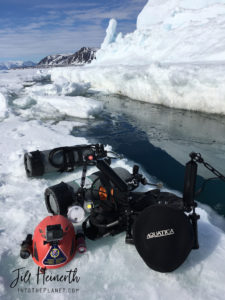 Scuba regulators are life-support devices. When you use these under ice and in extreme temperatures, it is important to have confidence in their operation. Regulator free-flows are one of the most significant hazards when diving under ice or in very cold water (less than 4°C). The sudden drop in pressure causes the condition as air passes from the cylinder through the first stage. When high-pressure air passes through the first-stage, it hyper-cools the metal moving parts. In a piston reg, small ice crystals can block the piston open, causing more airflow and trapping the piston open, creating a vicious feedback loop of more air, more ice, and a runaway loss of air. The air pressure overwhelms the downstream valve in the second stage, and all of a sudden, you are receiving high-pressure air right through the entire system, potentially even rupturing the LP hose or damaging the second stage (the downstream failsafe should prevent this, but I have seen it happen). This phenomenon can also occur less commonly with diaphragm regulators. To minimize the likelihood of free flow, use equipment conforming to CE standard EN250 (Cold Water Use). Diaphragm regs are generally better than pistons, which allow water to enter the first stage. Diaphragm regs can be fitted with cold water kits, reducing the cold water contact with metal, moving parts.
Scuba regulators are life-support devices. When you use these under ice and in extreme temperatures, it is important to have confidence in their operation. Regulator free-flows are one of the most significant hazards when diving under ice or in very cold water (less than 4°C). The sudden drop in pressure causes the condition as air passes from the cylinder through the first stage. When high-pressure air passes through the first-stage, it hyper-cools the metal moving parts. In a piston reg, small ice crystals can block the piston open, causing more airflow and trapping the piston open, creating a vicious feedback loop of more air, more ice, and a runaway loss of air. The air pressure overwhelms the downstream valve in the second stage, and all of a sudden, you are receiving high-pressure air right through the entire system, potentially even rupturing the LP hose or damaging the second stage (the downstream failsafe should prevent this, but I have seen it happen). This phenomenon can also occur less commonly with diaphragm regulators. To minimize the likelihood of free flow, use equipment conforming to CE standard EN250 (Cold Water Use). Diaphragm regs are generally better than pistons, which allow water to enter the first stage. Diaphragm regs can be fitted with cold water kits, reducing the cold water contact with metal, moving parts.
Procedures are critical too. Never inflate a dry suit, inflate your BCD and inhale simultaneously. To decrease the volume of gas passing through the first stage, do these things independently. Heavy breathing or significant use of the purge button increases the cooling effect of the airflow, so try to avoid both. Surface temperatures can also cause freezing in a first-stage that is exercised topside when wet.
Free flows can also occur at the second stage, usually on the surface, caused by low air temps and breathing a wet reg in the open air. To prevent this, never inhale on a second stage out of the water when you are in a cold environment. To begin the dive, inhale fresh air topside, then dip your head below water and exhale into the second stage. Do this two or three times to warm the second stage and then submerge and begin breathing in a controlled manner. Make sure the first stage is also submerged when possible.
Ensure that the cylinder and the air within it is as dry as possible. Keep the system protected from the elements until the last moment before diving.
Between dives, protect the first stage inlet so that no water enters when drying the dust cap. If possible, dry the second stage thoroughly before the next use.
Restrict yourself to no-stop dives at depths from which you can make a free ascent in an emergency or carry a redundant tank and regulator, so that you will be able to turn off the valve of the free-flowing tank quickly. Make sure you have practiced using your bailout. Free flows are extremely chilling on your mouth and entire body, and you want to switch to a bailout tank as soon as possible.
By following diligent gear safety and maintenance protocols you will protect yourself from incidents and be able to focus on the remarkable underwater fauna.
